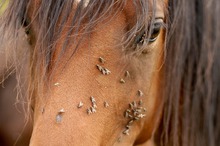Managing parasites in one horse starts with managing the parasite load of the herd, and managing the parasite load in the herd means managing pastures. Sometimes, horse owners let pastures become a source for parasites because they forget about some basic rules for good pasture management.

Pesky flies
Managing parasites in one horse starts with managing the parasite load of the herd, and managing the parasite load in the herd means managing pastures.
Manure is often a source for recycling parasites in and out of the horse's system. For this reason, horse owners are encouraged to remove manure from horse stalls daily. In addition to the daily removal, it's a good idea to make sure the manure is exposed to sun and wind which can dry out and kill parasite larvae.
Veterinarians recommend that fresh, uncomposted manure should not be spread on grazing pastures. Manure should be composted for at least a year to produce heat needed to kill the internal parasite larvae that resides in the manue.
In addition to composting manure, all bedding should also be composted. Recent studies have shown that shredded newspaper bedding reaches higher temperatures when composted than traditional straw or wood shavings, thereby more effectively killing any parasites in the bedding.
Veterinarians also recommend that pastures not be overcrowded or overgrazed. They recommend a ratio of one acre per horse for grazing pastures. In addition, they recommend that wherever possible, pastures should be rotated between cattle, sheep and horses, since parasites are different in each species and the rotational grazing allows many parasites to die off.
How horse get infected by parasites
Understanding how horses become infected is critical to understanding why and how pastures must be managed.
- Horses that are tempted to take just a few bites of this lush green grass while on their way to and from the bathroom area are likely to pick up large numbers of infective larvae, while other horses that resist the temptation do not become as heavily infected. This is one explanation as to why some horses on a pasture have very high egg count while others on the same pasture have very low egg count.
- Most horses seem to avoid grazing in the roughs, allowing the grass to grow very lush and green in these areas because of the added nitrogen fertilizer.
- Most horses do not graze pastures evenly. Rather, they have areas where they eat the grass very short (lawns) and areas where they pass most of their feces (roughs). Consequently, the eggs are going to be concentrated in the roughs.
- An infective larva generally travels no more 1.5 feet from the pile where it is passed as an egg by the horse, so there is a high concentration of eggs (potentially infective larvae) in the “rough” areas.
- Infective larvae actually climb up the blades of grass (but generally no more than 3 inches high) when it is warm and moist in order to make themselves much more available to an unsuspecting horse passing by. Grass in a pasture that is not taller than 3 inches results in a very high concentration of infective larvae at the tips of the blades of grass.
- Horses grazing on a short pasture are more likely to be exposed to more infective larvae because the larvae crawl up the blade of grass only about 3 inches.
Factors affecting egg distribution in horse pastures
Two other factors that affect the distribution of worm eggs in a pasture are nature and man.
- When it rains, eggs and larvae can be washed by the water over the pasture and be much more evenly distributed, thereby making it more difficult for horses to avoid them. We cannot control the rain but we may be able to control the drainage, thereby controlling the distribution.
- The best practice for dragging or mowing of pastures is to first remove the piles of manure from the roughs once a week. Then drag or mow the pasture when the weather is hot and dry, Ideally, horses should be kept off freshly-mowed or dragged pastures for five days. Larvae need moisture to survive, and exposing them to the heat causes them to use up more of their stored energy and die. Infective-stage larvae cannot eat because of a special coating and must rely on energy stored from eating bacteria during the previous stage while in the pile of manure.
Recommended reading for horse owners:
Understanding parasites, their life cycles, how they affect your horse and your pasture, and how to manage everything parasite-related can be challenging---there is a lot to learn. An excellent resource for anyone who owns or manages horses is the recently published Handbook of Equine Parasite Control by Craig R. Reinemeyer and Martin K. Nielsen.
The book provides basic biology, general principles of parasite control, assessment tools, case studies and advice. It is available from several sources including Amazon and Barnes & Noble, in both print and ebook versions.
Learn more about Parasite Control
